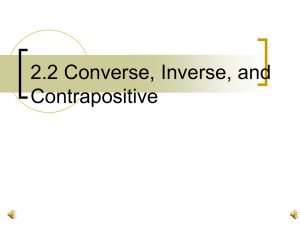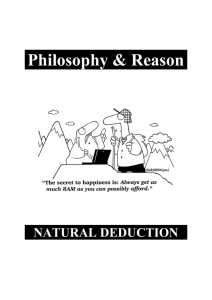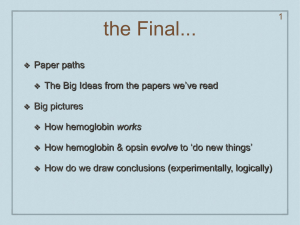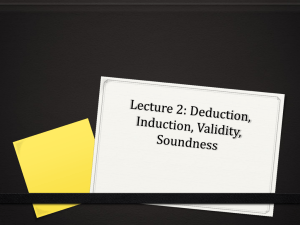Symbolic logic
advertisement
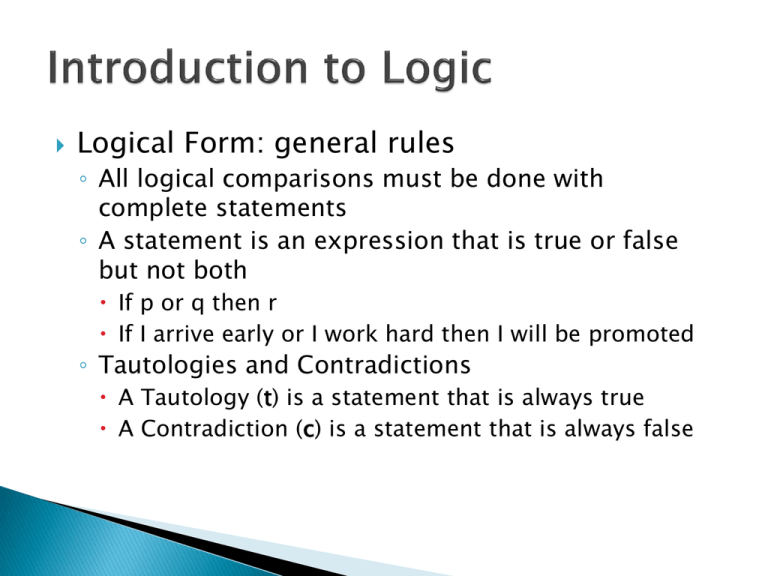
Logical Form: general rules ◦ All logical comparisons must be done with complete statements ◦ A statement is an expression that is true or false but not both If p or q then r If I arrive early or I work hard then I will be promoted ◦ Tautologies and Contradictions A Tautology (t) is a statement that is always true A Contradiction (c) is a statement that is always false The use of symbols ◦ ~ denotes negation (Not) If p = true, ~p = false ◦ ^ denotes conjunction (And) p^q = true iff (if and only if) p = true and q = true ◦ v denotes disjunction (Or) p vq = true iff p = true or q = true or p^q = true ◦ XOR: exclusive or P XOR q = (p vq) ^ ~(p^q), “p or q but not both” ◦ Order of operations ~ is first, ^ and v are co-equal P^q v r is ambiguous, so parenthesis need to be used: (p^q) vr ~p^q = (~p) ^ q Inequalities ◦ x ≤ a means x < a or x = a: (x < a) v (x = a) Same for x ≥ a ◦ a ≤ x ≤ b means (a ≤ x) ^ (x ≤ b) ◦ a (NOT)> x = a ≤ x Same for opposite ◦ a (NOT) ≤ x = a > x Same for opposite Truth Tables ◦ Every expression has a truth table ◦ This table represents all the possible evaluations of the expression ◦ To build a truth table, construct a table with cells corresponding to every possible value of the variables and the resulting value of the expression Logical equivalence ◦ Two statement forms are logically equivalent iff their truth tables are entirely the same Ex: p^q = q^p P = ~(~p) Showing non-equivalence ◦ Two methods: Use truth tables: this takes a long time Use an example statement like “0 < 1” The following are known as axioms. Use these to simplify logical forms easily ◦ Commutative Laws: p^q = q^p , pvq = qvp ◦ Associative Laws: (p^q)^r = p^(q^r), (pvq)vr = pv(qvr) ◦ Distributive Laws: p^(qvr) = (p^q)v(p^r) _ _ _ _ _ _ _ _ p v(q^r) = (pvq)^(pvr) Identity Laws: p^t = p, pvc = p Negation Laws: pv~p = t, p^~p = c Double Negative Law: ~(~p) = p Idempotent Laws: p^p = p, pvp = p Universal Bound Laws: pvt = t, p^c = c De Morgan’s Laws: ~(p^q) = ~pv~q, ~(pvq) = ~p^~q Absorption Laws: p√(p^q) = p, p^(pvq) = p Negations of t and c: ~t = c, ~c = t If Structures ◦ Statement form: “if p then q” Noted: p→q, p is Hypothesis, q is conclusion Truth Values: p→q is false iff p = true and q = false In statement forms, “→” is evaluated last Division Into Cases: Show pvq→r=(p→r)^(q→r) ◦ Build truth table and evaluate each term separately ◦ Then fill in each side of the equation and compare the values An If statement can be translated into an Or ◦ p→q = ~pvq ◦ People often use this equivalence in everyday language. ◦ By De Morgan’s Law ~(p →q) = p^~q Caution: The negation of an If does not start with “if” The Contrapositive of an If ◦ The contrapositive of p →q is ~q →~p A contrapositive is always logically equivalent to the original statement, so it can be used to solve equations A contrapositive is both the converse and the inverse of a statement The Converse and Inverse ◦ The Converse of p →q is q →p ◦ The Inverse of p →q is ~p →~q Neither is logically equivalent to the original statement If tomorrow is Easter then tomorrow is Sunday If tomorrow is Sunday then tomorrow is Easter? Only If ◦ “p only if q” means that p may occur only if q occurs Equivalent to: ~q →~p Equivalent to: p →q This does not mean “p if q”, which says that if q is true, p must be true An argument is a sequence of statements and an argument form is a sequence of statement forms. ◦ A basic argument is: p→q p :q _ All statements except the final one are the premises _ The final is the conclusion _ This is read: “If p then q; p occurs, therefore q follows _ The argument is valid iff the conclusion is true when all of the premises are true Testing an argument for validity ◦ Identify the premises and conclusion ◦ Construct a truth table showing the possible truth values for each statement and statement form ◦ If a situation exists in which all of the premises are true but the conclusion is false, the argument form is invalid To simplify, fill in all rows where all premises are true Modus Ponens: A famous argument form ◦ p→q: p:: q ◦ If p occurs then q occurs: p occurs:: therefore q occurs Modus Tollens ◦ p →q: ~q:: ~p ◦ If q doesn’t occur, p can’t occur ◦ A rule of inference is an argument form that is valid. There are infinitely many of them Modus Ponens and Tollens are rules of inference Generalization Specialization Elimination Transitivity Contradiction Rule: ◦ p::pvq and q::pvq ◦ p occurs, therefore either p or q occurred ◦ Used to classify events into larger groups ◦ p^q::p and p^q::q ◦ Both p and q occur, therefore p occurred ◦ Used to put events into smaller groups ◦ Pvq: ~q::p and pvq:~p::q ◦ P or Q can occur: Q doesn’t:: p must ◦ you can choose one by ruling the other out ◦ p →q:q →r::p →r ◦ If p then q: if q then r:: therefore if p then r ◦ ~p →c::p ◦ If the negation of p leads to a contradiction, p must be true. Proof by Division Into Cases ◦ pvq: p →r:q →r:: r ◦ p or q will occur: if p then r: if q then r:: r occurs ◦ You may only know one thing or another. You must simply show that in either case, the result is the same The Biconditional (iff) ◦ ◦ ◦ ◦ This is: “p if, and only if q” Denoted: p↔q and is coequal with → p iff q = (p→q) ^ (q→p) If p has the same truth value as q, p↔q is true An error in reasoning that results in an invalid argument Three kinds Using ambiguous premises (Statements that are not T/F) Begging the Question: assuming the conclusion without deriving it from the premises Jumping to a Conclusion: verifying the conclusion without adequate grounds Converse Error: ◦ p →q: q:: p – FALSE ◦ If p then q: q occurs:: p must occur – FALSE Inverse Error ◦ p →q: ~p:: ~q - FALSE ◦ If p then q: p doesn’t occur:: q can’t occur - FALSE
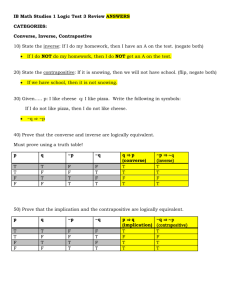

![overhead 5/rules of inference [ov]](http://s3.studylib.net/store/data/005889351_1-af9130702257227b4be99a75173ed5ee-300x300.png)
